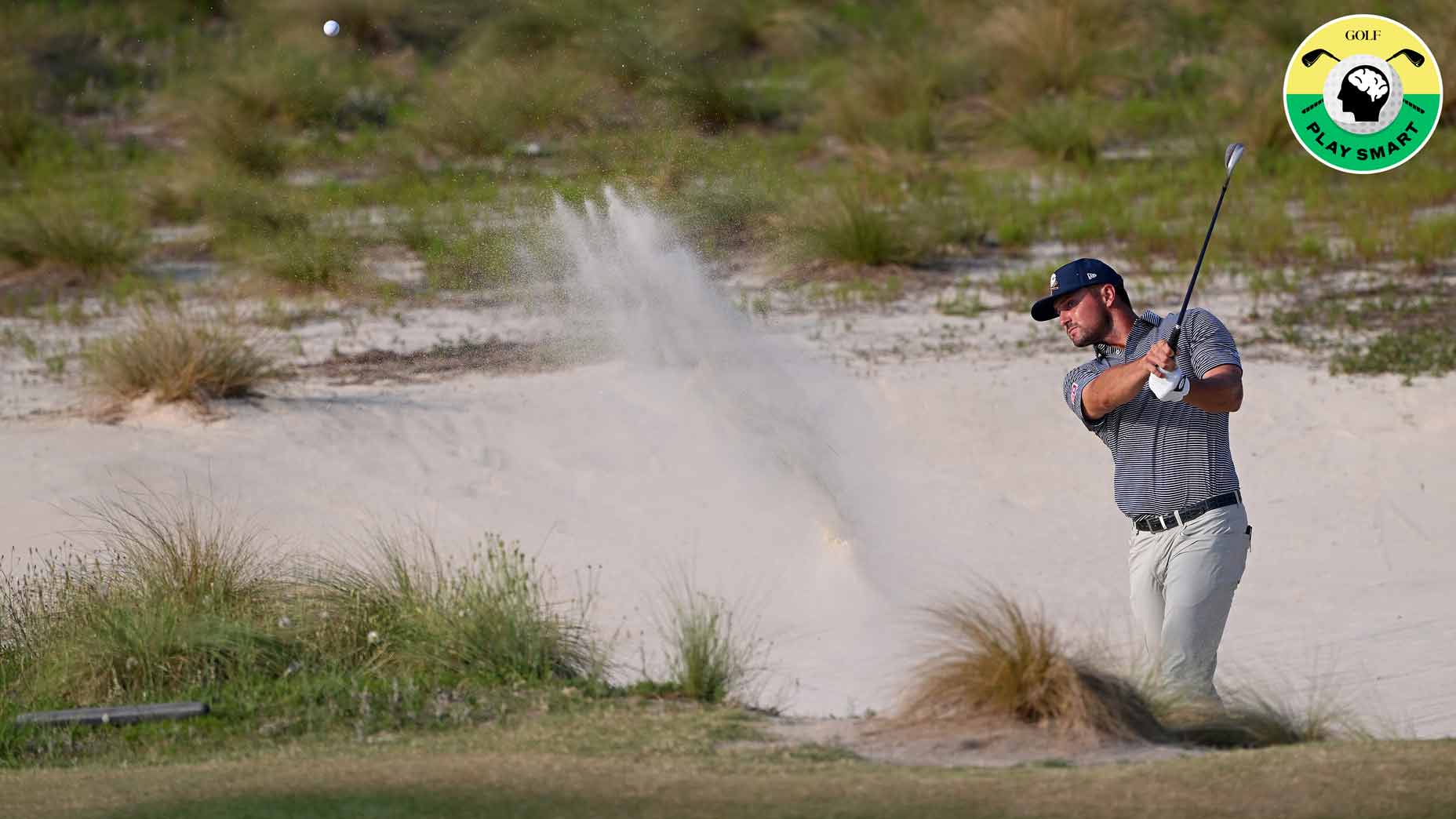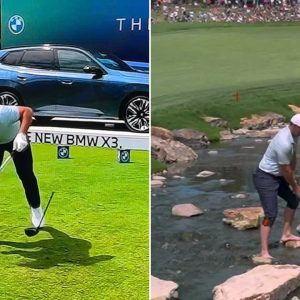Gary Player has the secrets for escaping the sand from any lie. Here they are
Pro golfer gary player hits a ball from a bunker
Follow these tips from Gary Player to escape bunkers every time.
Getty Images
Golf instruction is ever-evolving, but the best advice stands the test of time. In GOLF.com’s new series, Timeless Tips, we’re highlighting some of the greatest advice teachers and players have dispensed in the pages of GOLF Magazine.


This week, we take a look back at a series of bunker tips from Gary Player from our April 1975 issue. For unlimited access to the full GOLF Magazine digital archive, join InsideGOLF today; you’ll enjoy $140 of value for only $39.99/year.
Bunker shots give recreational golfers fits. When a weekend warrior hits their ball in a sand trap, the threat of a big number on the card is very real. For most, just getting the ball out of the bunker is considered a win.
Even for the pros, bunker shots aren’t a sure thing. Despite being among the best golfers on the planet, the average up-and-down percentage on the PGA Tour is only 53 percent.
To make things from the sand even more difficult, there are tons of different lies that make escaping the bunkers even harder. Whether it be a fried-egg or on some sort of slope, hitting a shot close from a strange lie is no easy feat.
In today’s edition of Timeless Tips, we hope to make things a little bit easier. Back in 1975, Gary Player contributed to GOLF Magazine his techniques for escaping all sorts of lies in the bunkers. Check them out below.
Gary Player’s sand secrets
Im always amazed at the way average players make bunker play such a complex matter. The swing they use in the sand doesn’t come close to the swing they use with, say, a 7-iron from the fairway into a green. The first rule of good sand play is to keep the swing as close to the normal as possible, regardless of the lie.
There is no need for a fancy wrist break in the takeaway and no need fora drastic deviation from the normal swing plane, as is so often preached in golf instruction articles. Any changes should be purely fundamental; in other words in the address position. Beyond these changes it’s a matter of understanding such things as the length of follow-through for short and long shots. You restrict your follow-through for a short shot to about waist height. For a long shot your hands carry the club up to a high finish, about the same as you’d use on a normal iron shot. The backswing length never, and I repeat, never changes.
An understanding of how much force to use in different situations is also very important. Obviously I can’t tell you how hard to hit each shot; you must experience this for yourself by practicing. From practice you also gain understanding of what happens to the ball when, for example, you open, square or close the clubface. With the clubface open you can expect the ball to fly higher and for less distance and to stop quickly. Square, the ball will fly slightly lower, longer and run a little more. With the clubface closed you’ll have no backspin, a low trajectory and a lot of forward roll.
Your lie in the bunker will not always be a good one so you must also develop an understanding of how the ball will react in various situations and the compensations to make. Let me give you an example of what I mean.
Bunker Shots
bryson dechambeau hits bunker shot on the 18th hole at pinehurst no. 2
Bryson DeChambeau says this is the ‘most important thing’ on bunker shots
By: Zephyr Melton
In the Masters tournament, playing with Bob Murphy on the short 12th hole over the creek, I hit my tee shot over the green into the bunker behind the pin. The shot I was left with was to a pin placement eight feet short of the water, and the green was like rock. To make matters worse the ball was plugged in a downhill lie. From experience I knew very well that there was no way I could put backspin on the shot. No one has ever been able to get backspin from a plugged lie. All I could do was try to land the ball just over the greenside lip, allow for the run and hope for the best. As hoped for, the ball landed just on the green, and to the amazement of Bob Murphy, who had seen how bad the lie was, and myself, ran into the hole for a 2. I would have to say that a lot of luck was involved, but experience also played a hand. Had I tried to hit to the pin, I’d have been in the lake and at best would’ve made a double bogey. Experience payed off.
Later in this article I’m going to give you the benefit of my experience in the hope it will help you gain a better understanding of sand play. First, though, I want to outline the basic fundamentals that must be ingrained before you can hope for any kind of an improvement.
The first thing, once over the ball, is to dig your feet well down into the sand to form a secure base for your swing because if you slip you’ve got no chance. Now to the basics.
Bunker basics
The fundamentals I’m about to outline are fairly straightforward, there are exceptions to the general rule, which I’ll go into in detail when we discuss the various lies later.
Your stance should be slightly open with the ball positioned just inside your left heel. Choke up on the club so there is approximately an inch of rubber showing beneath your right thumb and index finger. I’ve found through experience that I have more control by gripping down the shaft. Your weight should favor the left side and your hands should be slightly ahead of the ball to help you initiate your swing smoothly. Aim for a spot in the sand 1% to two inches behind the ball. With these key thoughts ingrained in your mind I’m going to reveal what I think is the secret of good bunker play.
Sam Snead and Julius Boros, two of the finest trap players in the game, have something in common: long, and very slow, backswings. The slower you swing the easier it is to coordinate your movement, the longer you swing the more time you have to gauge distance and gain that all important feel. Study the pictures on the previous page. You see that I too have a long backswing. In fact, the club is almost horizontal. You will-also see, on the final two pages, that I am in the same position for a shorter shot from a plugged lie. Note: the only variation is in the followthrough. Again, the backswing length never changes.
Now you have my method in a nutshell. The only other ingredient you need now, to become proficient in the sand, is a little understanding, and I’ll help you with this by outlining some of the situations you’ll encounter on the course.
Uphill lie
From an uphill lie the ball naturally flies much higher. To compensate you must use more force — hit harder — in your follow-through. First, though, remember to dig your feet in; if you sink in after your swing starts you’ll hit behind the ball and leave it in the bunker. Try as much as possible to make the plane of your swing match the contour of the sand. You can accomplish this by setting your weight back on your right side. With your weight back you’ll find swinging up through the sand easier. Your follow-through, however, will be restricted by the steepness of the slope and can cause you to quit on the shot, meaning to stop just after impact. To compensate take a firmer grip on the club, allow for some jarring in your hands, and make a conscious effort to lead through the ball with your hands as far as possible.
Bunker Shots
If you’re struggling with mishits from greenside bunkers, Cleveland Golf ambassador Jake Hutt shares some tips to see improvement
Short-sided in a greenside bunker? Here’s how to get up and down
By: Nick Dimengo
The natural tendency with most players from an uphill lie is to leave the shot too short of the hole, because of the height and lack of force they use in their swing. Don’t be short; always try to get the ball past the hole!
In Japan, in the Japan Airlines tournament, I was faced with a crucial uphill lie in the bunker on the last hole. Earlier, knowing I needed a par-5 on the last hole to win, I had hit two super wood shots, leaving myself a soft sand wedge from the fairway into the green. Wouldn’t you know, I hit the worst shot in the world right into the face of the bunker. Peter Thomson, the great Australian player, and three other players in the clubhouse were tied for the lead at that point. When I hit the ball in the bunker, they all started putting on their shoes ready for a playoff. But, I got in that bunker, ground my feet down into the sand, set my weight back on my right side, opened the clubface and really hit down into the sand. The ball popped up and came down stone dead for a “gimme putt.” This example shows the importance of understanding.
Ball under lip
When you find yourself under the lip of the bunker the same fundamentals apply as for the uphill lie. However, because you need additional height on the shot to get over the lip, you must turn the clubface wide open. Instead of setting your hands slightly ahead of the ball in your address, move them back level with the ball. Moving your hands back will allow your right hand to work under your left more, thus producing greater height on the shot. The farther ahead your hands are, the lower the trajectory will be.
In this difficult situation the common error is to hit fat, taking too much sand, which results in the ball barely making it over the lip then getting stuck in the fringe of the bunker. This happens because the player fails to get enough weight back on his right side to assist him in hitting up through the slope and because, as with the uphill shot, there isn’t enough force applied in the downswing. Providing you aim for that spot 1% to two inches behind the ball it is unlikely that you’ll go very far beyond the hole. That’s a promise.
Downhill lie
Downhill you want to make the plane of your swing match, as much as possible, the contour of the bunker. To help accomplish this, kick your right knee in toward your left. Kicking your right knee in will set most of your weight over on your left side while setting your body at right angles to the slope.
Because of the downhill slope, the ball will, if you have the club only slightly open, have a low trajectory, so open the clubface a little more. Remember first to dig your feet well into the sand.
In the actual execution, even if you have to move forward laterally, you must hit down; otherwise you’ll catch the ball rather than the sand behind it and hit the shot thin. Be very conscious of hitting down through the sand and making your hands lead down and through.
Ball above your feet
When the ball is above your feet never let the clubface turn over (close). The fact that the ball is above your feet makes you swing flatter, which automatically causes the ball to go left. Your first compensation, therefore, must be to align yourself well to the right of the target. Your instinct will tell you the ball is going to go left. You can prevent it going farther left by weakening your right-hand position on the club. That is to say, moving your hand farther over to the left, so that the “V” formed by your index finger and thumb points straight up to your chin. This simple change will help eliminate the possibility of closing the clubface.
Bunker Shots
scottie scheffler hits a bunker shot during the opening round of the 2024 rbc heritage
An easy way to become a better bunker player (without even hitting balls)
By: Zephyr Melton
You must also choke up on the club a little more. If necessary go all the way to the bottom of the grip; this will ensure that you don’t dig down too deeply into the sand, a common error in this situation. You will find that the sand offers about the same restriction to the clubhead’s path as a normal bunker shot, so less force is required and more finesse. Above all: Keep the over-all action slow, long and smooth.
Ball below your feet
When the ball is below your feet remember first that the ball is going to travel right (the opposite of an uphill lie). You must, therefore, start by aligning farther left of the pin.
There is a tremendous danger, with the ball below you, of skulling or at least hitting the ball thin. You guard against this by making these changes.
1. Grip up on the shaft of the club; the amount depends on the severity of the slope.
2. Tread the sand down until you have a rock-like base and firm footing.
3. Stand as close to the ball as possible.
4. Sit down, really flexing your legs, and get as comfortable as possible.
When executing the shot, keep that slow, long backswing in mind and lead your hands down and through as much as possible. Throughout the swing keep your knees at the same flex as at address. This shot also requires more finesse and smoothness than force.
Plugged lie
As I said earlier there is no possible way to get backspin from a plugged lie. You must allow for a lot of roll.
Move the ball back in your stance. This automatically sets your hands ahead of the ball, creating a steeper downswing arc, which is essential in helping you get down under the depression in which the ball sits. But the real assist comes from eliminating the bounce, the part of the club that protrudes below the leading edge, by closing the clubface. Closed, the clubhead is like a knife; the leading edge cuts down under the sand with ease.
As a result of the depth the club travels under the ball, you can expect your followthrough to be somewhat restricted. This does not mean that you need to make a gorilla swing to get the ball out. Too much force is the most common error. In fact, very little force is required; the closed clubface is going to do all the work for you.





